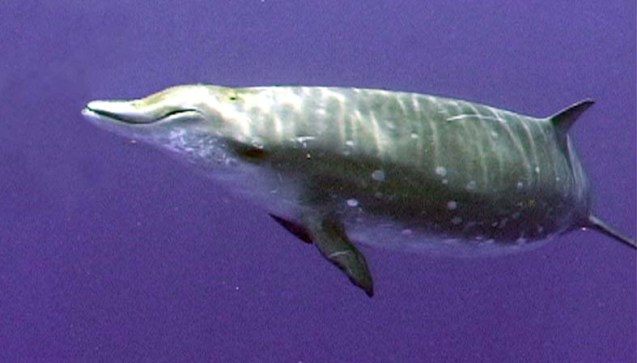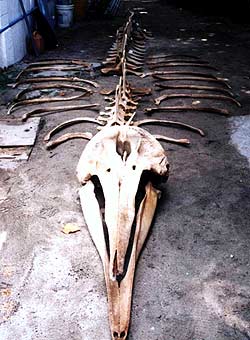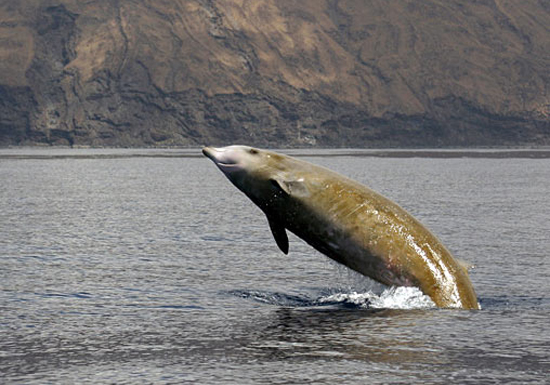New Whales and the Wonders of the Deep
Posted by: mystery_man on January 21st, 2011
New Whales and the Wonders of the Deep
By- Brent Swancer
There seems to be a common misconception among many that there is nothing new under the sun, that we have discovered all of the large species of animals that are out there to be found. This is a stubborn notion that those of us in cryptozoology have had to contend with time and time again, and no matter how much we argue otherwise or show remarkable instances of new species discoveries, we are still faced with that idea that the dark corners of our planet’s wildest places have already given up their secrets. Many would think that all there is left to find are small animals that have somehow evaded our all seeing eye.
Of course, this couldn’t be further from the truth. This planet we call home is still well cloaked in remote wilderness that we have only scratched the surface of, and we are far from fully cataloguing its vast biodiversity. It is estimated that there are thousands of new species left to be discovered. Even in modern times we continue to uncover new species at a fairly good rate, and some of those are large or surprising new animals.
Perhaps nowhere is this influx of new species more apparent than in the world’s oceans, those vast, enigmatic bodies of water that remain little explored and a haven for the unknown, and perhaps nothing could be as large as discovering a new type of whale. Yet this has happened more recently and more often than many may think.
One very recent discovery happened when a Japanese research team identified a new species of baleen whale. Baleen whales are whales that utilize structures known as baleen plates to filter out food such as krill or plankton.
The new species was described based on the remains of 8 whales harvested in the 1970s in the Indian Ocean and Solomon Sea, plus a ninth specimen that was recovered on the remote Japanese island of Tsunoshima after being killed in a collision with a boat.
The new discovery marked the culmination of decades of research that began with an analysis of the remains of eight whales by Dr. Shiro Wada, chief of the Cell Biology Section of the National Research Institute of Fisheries Science in Japan. In the 1970s, Dr. Wada examined these specimens and concluded based on external morphology alone that these whales were something unique, and not Bryde’s whales (Balaenoptera brydei) a known species that these eight whales were originally thought to be. Concerning these specimens, Dr. Wada stated:
“Bryde’s whales grow up to over 14 meters long, however even the smallest of those eight whales was relatively small, 11.5 meters in length. Detailed reexamination of the available samples of their vertebral bones revealed that all the individuals but the smallest female had reached physical maturity. Therefore, based on the size data, it was not possible at all for us to consider that they were Bryde’s whales. Furthermore, the color and proportion of their baleen plates were distinctly different from those of Bryde’s whales.”
Photographs of the specimens also later revealed that they bore a stronger resemblance to fin whales than Bryde’s whales.

Bryde’s whale
These eight specimens remained a curiosity until Dr. Wada wrote a draft paper on yet another carcass found on the island of Tsunoshima, which caught the attention of a Dr. Tadasu Yamada, chief of the Division of Mammals and Birds at the National Science Museum, Tokyo, Japan. Dr. Yamada decided to investigate, and it was determined that the carcass bore strong similarities to the eight specimens originally examined by Dr. Wada.
The Japanese scientists used mitochondrial DNA testing to substantiate the conclusions they had reached through analysis of external morphology, skeletal structure, and allozyme comparisons, and came to the realization that these nine specimens were of the same species, and that they had discovered a new species of baleen whale. What’s more, not only had they described the new species, but through analyzing the mitrochondrial DNA of various baleen whale species during the course of their research, they made the secondary finding that another whale that was previously thought to be one species was actually two. It came to their attention that Eden’s whales, which had originally been thought to be synonymous with Bryde’s whales, were in fact a separate species.
The findings made by the Japanese research team essentially bumped up from six to eight the number of species within the genus Balaenoptera , a genus of baleen whales that includes the largest animal on Earth, the blue whale. The original six known species in this genus added the reclassified Eden’s whale (B. edeni), as well as the new species discovered by the team, which was christened B. omurai in honor of Dr. Hideo Omurai, a scientist renowned for his contributions to whale studies. It was formally described in November, 2003.

Balaenoptera omurai
This discovery is remarkable in that it is the first discovery of a new type of baleen whale in nearly a hundred years.
While the findings of this team of Japanese scientists are exciting to be sure, how about the discovery of a new genus of whales?
In 1882, a worn whale skull was found on a beach in Queensland, Australia that did not fit in with any known species at the time. The skull eventually found its way to the Queensland Museum, where it was basically forgotten until 1926, when Heber Albert Longman found the skull and recognized it as a new species of whale in the family Ziphiidae, a type of whale with mouths like beaks similar to dolphins. Longman named this species Mesoplodon pacificus.
With only one damaged skull to go on, it was perhaps inevitable that this finding would be questioned by others. Many experts in the field argued that the skull was merely that of a known species of beaked whale.

A beaked whale
In 1955, a second skull washed up, this time on the east coast of Africa. The skull strongly resembled the one which had been found in Queensland, and this caught the attention of a Joseph C. Moore, then curator of the Field Museum of Chicago. In 1968, Moore published a taxonomic review of the five known genera of beaked whales, and based on the skull findings, classified the M. pacificus that Longman had found as a new genus. To reflect this new status, Moore renamed the new whale Indopacetus pacificus.
In addition to these skulls, in 1966 during biological surveys in the central Pacific for the Smithsonian Institute a herd of 25 to 35 unidentified whales was photographed by Ken Balcomb near the equator. The mysterious whales were different in appearance to any known species. They were larger than most beaked whale species, and were grayish brown in color with a tan forehead. At the time, it was guessed that these whales were members of a subset of beaked whales known as bottlenoses.
The skulls and the photographs remained a mystery, and left whale biologists scratching their heads. Over the years, sightings of these strange whales popped up all over the tropics as well as photographs, video footage, and even recordings of the animals.
It wasn’t until very recently that scientists looked at this accumulated evidence and tied it all to the original Queensland skull found over a hundred years before. Scientists found that what was being seen matched very closely the skulls that had been found, as well as other remains that had turned up. It was also ascertained that these whales that were being photographed in the tropics were significantly different in appearance to the southern bottlenose whales that they had long been suspected as being. When all evidence was considered, it was found that it all tied together to the skulls found in 1882 and 1955, and that indeed this was a new type of whale.
To this day, the whale is still known as a separate genus, I. pacificus, also known as the Indo-Pacific beaked whale or Longman’s beaked whale in honor of the man who first recognized the whale as something unique. A living specimen of this species has never been obtained, and it is known from only photographs, sightings, video footage, five skulls, and one complete skeleton.

Skeleton of Indopacetus pacificus
Beaked whales are famously shy and difficult to study. Even researchers rarely see them, and due to this there are many instances of very recently discovered species known from only a handful of specimens.
Perrin’s beaked whale (Mesoplodon perrini) for instance, has never been recorded alive. It is known from 5 specimens, the first found in 1975, all found off the coast of California between San Diego and Monterey. It was formally described in 2002. Shepherd’s beaked whale, also known as the Tasman whale, is known from only four specimens. The Pygmy beaked whale (Mesplodon peruvianus) was originally discovered off Peru in 1991 and is known from only twelve specimens. The list goes on.

Beaked whale
In the case of animals like the beaked whales, we have an extremely shy creature that is known to retreat under the waves at the sound of a boat approaching and stay out of sight until all observers are gone. If this can be the case with whales, what other large, elusive animals might be out there evading our detection in a similar fashion? It is obvious that large species of animals can remain elusive and hidden from us. We have species described in the absence of live animals, confirmed from only sightings and a very few specimens that were very often stumbled across by chance and in poor condition. What other wonders remain out there in the vast deep, concealed from view, their remains simply not found yet?
The ocean is a big place, its depths little understood. If we can turn up new species and even a new genus of whale even in this day and age, imagine what else could be out there cruising through the murky waters of the world’s oceans. Perhaps the next big animal discovery in our oceans will be not a whale, but something even more amazing. We may even uncover something that could challenge what we think we know about this planet of ours; a planet that very much still has its secrets.
About mystery_man









Excellent post. Well researched and presented. As always.
Great post. I do agree. There might be something bigger than the whale that’s a fish type or reptile. Maybe a 120ft Squid.
Well, yeah … kinda.
When a discovery of a new species of large animal is made, it is appropriate to ask 3 questions.
1. Would a trained biologist know at first glance that this creature is new to Western science?
2. Would a layman of average education believe at first glance that this creature is new to Western science?
3. Does the present existence of this creature force a paradigm shift in biology?
If a real Bigfoot carcass were found as a type specimen, the answers would be Yes, Yes, and Yes. If a Mothman were captured, the answers would be Yes, Yes, and Yes. If a surviving plesiosaur were found, the answers would be Yes, Yes, and Yes. I don’t think it’s unfair to say that cryptozoology only has to do with those cases where all 3 answers are Yes. The platypus is a perfect example of an animal for which the answers were all Yes.
For the coelacanth, though, the answers would be Yes, No, Yes. For the kha-nyou, Laonastes aenigmamus, the answers are probably Yes, No, No. For this new species of whale, the answers are No, No, No.
m_m (I may start calling you Brent…someday, when photos and posts are confirmed by forensic evidence): another great job.
Which in a way points up *why* we consider science to have an ‘all-seeing eye.’
Whales can be particularly difficult animals to identify without specimens in hand. I’d agree with Fhqwhgads that we have (to use his model) a “no,no,no” with practically all of the recent whale discoveries. Even such a celebrated animal as the kouprey qualifies, in my opinion, as a “no,no,no” as the type specimen had to grow out of calfhood for the ID to finally be made by trained scientists (and it didn’t really involve shifting any paradigms, just “this cow is actually a different species, now that we got a close look”). The saola may have been frequently sighted by servicemen in Indochina (a “no” on 2), and I’m not sure a new genus is a paradigm shift (“no” on 3). (I consider, say, the discovery of Eris to be a paradigm shifter, as it was bigger than a known “major” planet, which no longer is considered “major.” If we ever discovered a bird with no feathers, or a mammal with no hair, they’d shift paradigms too.)
When, however, we are picking fly crap out of pepper with the regularity that scientists do with ‘new’ kinds of known animals, it’s easy for laymen – whom scientists have to make nice with to build their careers – to get the opinion that science sees all, knows all, because how the *heck* could you figure out that this is a new whale, unless you’re watching for it all the time? How are you finding new MICE, ferpetes, without a magnifying glass constantly combing the earth? Thus the reaction to animals like the sasquatch and yeti (“someone would HAD TO HAVE [x] by now…”).
Most scientific research is unearthing new facts about things science already knows (e.g., “new” species of accepted animal types). When one starts talking yetis and sasquatch, however, one gets into a fundamentally different kind of science, the researching of the unknown and not accepted. The rules are completely different. It’s sort-of-expected now to find variations in known animal types. A new whale in the ocean? Can happen. A new species of tree frog? Sure. Apes, however, do not live in the temperate zone, period. So everyone laughs at the notion rather than looking at the evidence and asking, does this point to the reality of something we don’t accept yet?
When no one expects to find it, it can usually be expected that no one will.
Very interesting article, and I particularly like your response, Fhqwhgads. (may i call you Fhqw?)